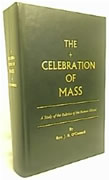 Jeg skrev for noen uker siden at jeg hadde mottatt J. B. O’Connells bok The Celebration of the Mass: A Study of the Rubrics of the Roman Liturgy. Nå har jeg lest nesten 200 av de 600 sidene og lærer en hel del – og det handler nesten utelukkende om (slik jeg skrev sist gang) hvordan messens hellige offer rett skal bæres fram for Gud.
Jeg skrev for noen uker siden at jeg hadde mottatt J. B. O’Connells bok The Celebration of the Mass: A Study of the Rubrics of the Roman Liturgy. Nå har jeg lest nesten 200 av de 600 sidene og lærer en hel del – og det handler nesten utelukkende om (slik jeg skrev sist gang) hvordan messens hellige offer rett skal bæres fram for Gud.
Utgaven jeg har kjøpt er fra 1963, og har derfor med alle bestemmelser som kom før konsilet. O’Connell har derfor også med et appendix han har kalt THE ACTIVE PARTICIPATION OF THE PEOPLE IN THE LITURGY, der har tar med alle nyere bestemmelser om folkets deltakelse i messefeiringen, inkl De musica sacra et sacra liturgia. Instruction on Sacred Music and Sacred Liturgy. Sacred Congregation for Rites – September 3, 1958. Dette dokumentet kan i sin helhet leses her (pdf-fil).
Der skriver O’Connell:
1. On September 3, 1958 – a significant date, the feast of St. Pius X S.R.C. issued an important Instruction De Musica Sacra et Sacra Liturgia, the chief purpose of which is to fulfill the desire of St. Pius X, Pius XI, and Pius XII, that the people -who form the liturgical assembly with the celebrant as its president – in the greatest possible measure according to local circumstances, should take a conscious, intelligent, active part in the sacred liturgy, especially in the Mass. This active participation is demanded by the very nature of the Mass and by the structure of the Roman rite, and is the right and duty of the congregation to give since by the character of Baptism they share in the priesthood of Christ, so that they, after their own fashion, offer in the Holy Sacrifice, with the priest, the Divine Victim to God the Father. The liturgy is the worship of the entire community, of the Mystical Body.
Participation in Mass
2. Participation in Mass must, of course, be first of all internal, when the people by attention and good will are united with Christ, and with him, in him, and through him offer the Sacrifice and themselves to God. But this participation should also be external by correct ceremonia and by liturgical gesture (signs of the cross, striking the breast), but especially by voice, in song and speech. The participation of the faithful is complete when, in addition to the internal participation and the external sharing by voice and action, they receive Holy Communion.
Fortsettelse følger.
